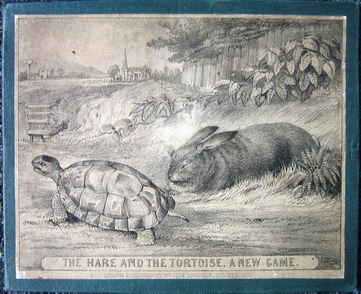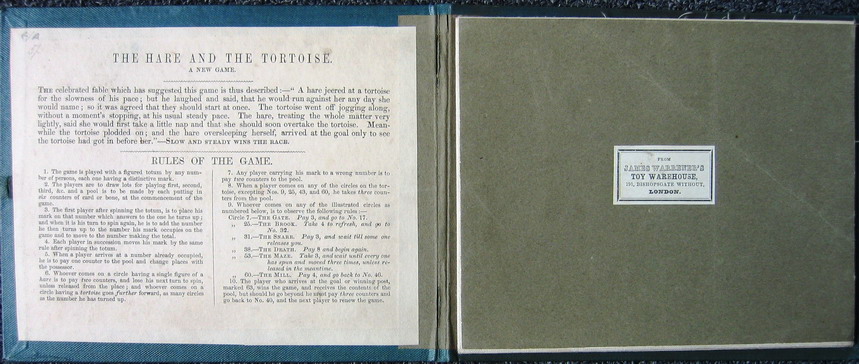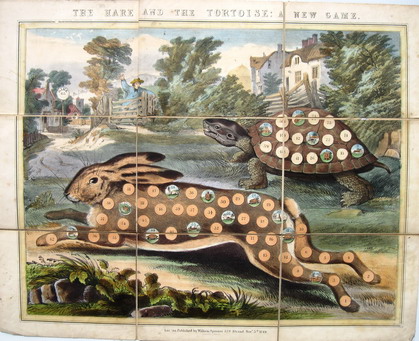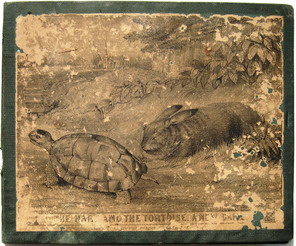Giochi dell'Oca e di percorso
(by Luigi Ciompi & Adrian Seville)
(by Luigi Ciompi & Adrian Seville)

|
Giochi dell'Oca e di percorso
(by Luigi Ciompi & Adrian Seville) |

|
 |

Torna alla ricerca giochi (back to game search) |
 |
| Hare (The) and the Tortoise: a New Game | ||
 |
Versione stampabile
 |
Invia una segnalazione

|
     |
primo autore: | Anonimo |
| secondo autore: | Spooner William | |
| anno: | 1849 | |
| luogo: |
Inghilterra-Londra |
|
| periodo: | XIX secolo (2°/4) | |
| percorso: | Percorso di 63 caselle numerate | |
| materiale: | carta incollata su tela (engraving on paper with linen backing) | |
| dimensioni: | 430X530 | |
| stampa: | Litografia colorata a mano (hand-coloured engraving) | |
| luogo acquisto: | ||
| data acquisto: | ||
| dimensioni confezione: | ||
| numero caselle: | 63 | |
| categoria: | Mondo animale e vegetale | |
| tipo di gioco: | Gioco di percorso | |
| editore: | Published by William Spooner, 379 Strand. | |
| stampatore: | Spooner William 379 Strand nov.r 5th 1849 | |
| proprietario: | Collezione E. C. - A. Seville | |
| autore delle foto: | E. C. - A. Seville | |
| numero di catalogo: | 1336 | |
| descrizione: |
Gioco di 63 caselle numerate distribuite sul corpo di una lepre e di una tartaruga. Tra gli animali che sostituirono le oche in alcune versioni del gioco non ci furono solo le scimmie come dimostra "La lepre e la Tartaruga" pubblicata a Londra nel 1849. Il gioco era innovativo anche perchè divide il percorso tra una bellissima immagine di una tartaruga e una ancora più bella di una lepre. Il percorso inizia sulla zampa posteriore sinistra della lepre e si articola lungo le zampe fino alla casella 8. La casella 9 si trova sulla tartaruga ma il percorso ricomincia poi nuovamente sulla lepre. Alcune delle caselle riportano una piccola immagine di una lepre ed è qui che il giocatore perde un turno e deve versare due gettoni nel piatto. Le caselle con la tartaruga raddoppiano il punteggio come nel Gioco dell'Oca mentre molte delle caselle sulla tartaruga ricompensano il giocatore con tre gettoni. Ci sono poi gli imprevisti simili a quelli che si trovano nel Gioco dell'Oca con il quale questo gioco condivide anche la lunghezza del percorso di 63 caselle. Il giocatore deve prestare attenzione nel cercare sui disegni la posizione delle caselle in quanto secondo il regolamento qualsiasi giocatore che si trovi sulla casella sbagliata dovrà versare due gettoni nel piatto. REGOLE: non presenti sul tavoliere. CASELLE: mute. REFERENZA 1 WHITEHOUSE, Francis Reginald Beaman, (pag. 66): HARE AND THE TORTOISE (The). A new Game. London. Published by William Spooner, 379 Strand, Nov 5th. 1849. A coloured lithograph by L’Enfant, size 21 ½ in X 17 in, mounted in 9 sections on linen, folded into hinged boards, cloth-covered, with picture label on front. Rules pasted inside front cover. The game sheet is a country scene with picture of both hare and tortoise in the foreground, having numbers in circles upon both of them-more on the hare than the tortoise. A race game as described in the rules. REFERENZA 2 Game 39: The Hare and the Tortoise The Hare and the Tortoise: a New Game. London: William Spooner 379 Strand Novr. 5th. 1849. Lithograph by [John Anthony] L’Enfant (1825?–1880) of Marylebone, London, with original hand color, 43 x 53 cm.; dissected and laid onto linen in 3 x 3 panels, folding into cardboard covers, 16 x 19 cm., decorated with a monochrome lithograph of a hare and a tortoise, in brown ink and containing the rule sheet. Refs.: Ciompi/Seville 1335; Whitehouse, p. 66. The publisher William Spooner included several board games in his varied output of printed novelty items, especially those based on maps. In some of these, he used a two-dimensional random walk, instead of a unicursal track. In the present game, the track is unicursal but is distributed between the hare and the tortoise shapes. The track starts at the hare’s rear left toe, winds about between its back legs until space 8 is reached -but space 9 is found on the tortoise—after which the track reverts to the hare for a bit before heading off again. Within small circles, some of the spaces show a hare, where the player must miss a turn and pay two counters to the pool. The circles showing a small tortoise, however, act as goose spaces, doubling the number spun on the totum. Most of the spaces on the tortoise itself reward the player with three counters. Finally, there are hazard spaces e.g., Space 25: The Brook – take 4 to refresh and go to space 32; Space 31: The Snake – pay 3 and wait till someone releases you. Space 38: The Death – pay 8 and begin the game again. The hazards are clearly reminiscent of the Game of the Goose, with which this game shares the characteristic track length of 63. For all its apparent novelty, this is not a better game than Goose, though the player needs to be alert in finding where to move. Any player ”who carries his mark to a wrong number must pay 2 to the pool” and this rule may well have been often invoked! (Adrian Seville) REFERENZA 3 "The Hare and the Tortoise: A New Game", London: William Spooner, 1849, with wood box with sliding lid and paper label, game: 52 x 44 cm., box: 5 x 5.5 x 7.5 cm. (Yale University GV1199 .H37 1849 Flat.) HOW TO PLAY THE GAME: In this race game, the track starts at the hare’s rear left foot and winds about between its back legs until space 8. Space 9 then appears on the tortoise, but the numbering reverts to the hare with space 10. This apparent confusion was done on purpose, for as the instructions direct, any player “who carries his mark to a wrong number must pay 2 [counters] to the pool.” The wood box designed to hold the counters for this game may be seen in the case below, with the cover to the game. (Patrons) Exhibitions: - "The Royal Game of the Goose four hundred years of printed Board Games". Exhibition at the Grolier Club, February 23 - May 14, 2016 (Prof. Adrian Seville). - "Instruction and Delight: Children's Games from the Ellen and Arthur Liman Collection" (Yale Center for British Art, 17 January-23 May, 2019). |
|
| bibliografia: |
1) WHITEHAUSE, F.R.B.: "Table Games of Georgian and Victorian Days", London, Peter Garnett, 1951. 2) GOODFELLOW, Caroline: "A Collector's Guide to Games and Puzzles". Secaucus, New Jersey, Chartwell Books-London, Quintet Publishing Limited 1991. 3) GOODFELLOW, Caroline: "The Development of the English Board Game, 1770-1850", in Board Games Studies 1, 1998. 4) GOODFELLOW, Caroline: "Jeux de société. Le guide du collectionneur des jeux de société depuis le XVIIIe siècle jusqu’à nos jours", (Edizione francese) Carrousel MS, 2001. 5) SEVILLE, Adrian: "The Game of Goose: and its influence on cartographical race games" Journal of the International Map Collectors' Society, Winter 2008 N°115 2008. 6) SEVILLE, Adrian: "The geographical Jeux de l'Oie of Europe." In "Belgeo" 2008 3-4 2008. 7) GOODFELLOW, Caroline: "How We Played: Games From Childhood Past", History Press, 2012. 8) QUINN, Brian - CARTWRIGHT, William: "Geographic Board Games". Geospatial Science Research 3. School of Mathematical and Geospatial Science, RMIT University, Australia. December 2014. 9) SEVILLE, Adrian: "The Royal Game of the Goose four hundred years of printed Board Games". Catalogue of an Exhibition at the Grolier Club, February 23 - May 14, 2016. 10) LIMAN, Ellen: "Georgian and Victorian Board Games: The Liman Collection", Pointed Leaf Press, 2017. 11) NORCIA, Megan A.: "Gaming Empire in Children's British Board Games, 1836-1860". Studies in Childhood, 1700 to the Present. Routledge, 2019. 12) SEVILLE, Adrian: "L'arte dei giochi da tavolo. Oltre un secolo di storia e divertimento dalla fine del Settecento all'inizio del Novecento." Edizioni White Star, 2019. 13) PARLAK, Omer Fatih: "Seafearing through the Perspective of Historic Board Games", in DGSM, Köllen Druck+Verlag, Bonn 2020. |
|
| "The Development of the English Board Game, 1770-1850" (Caroline G. Goodfellow) | ||
| Games of Amusement. "Table Games of Georgian and Victorian Days". (Francis Reginald Beaman, Whitehause) | ||
Vai alla ricerca giochi Vai all'elenco autori